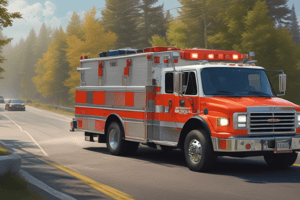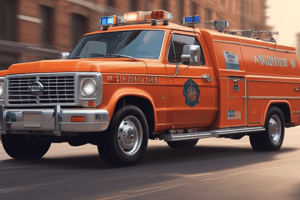Podcast
Questions and Answers
What should drivers do when approaching a controlled intersection with a red light or stop sign?
What should drivers do when approaching a controlled intersection with a red light or stop sign?
- Ignore other road users and focus solely ahead.
- Proceed without stopping if no vehicles are present.
- Only check for vehicles behind them before moving.
- Account for all lanes of traffic before proceeding. (correct)
Which of the following is a responsibility of the officer in the front passenger seat of an emergency vehicle?
Which of the following is a responsibility of the officer in the front passenger seat of an emergency vehicle?
- Operate the vehicle at high speeds during emergencies.
- Monitor traffic signals and direct the driver accordingly.
- Ensure the driver follows safety policies and procedures. (correct)
- Take over driving when the driver makes a mistake.
Under what circumstances should drivers reduce speed and exercise caution?
Under what circumstances should drivers reduce speed and exercise caution?
- When they are in a rush to their destination.
- Only when they see other emergency vehicles.
- When driving on highways.
- In construction zones and when a flagger is present. (correct)
What must emergency vehicle drivers do regarding traffic control signals during non-emergency travel?
What must emergency vehicle drivers do regarding traffic control signals during non-emergency travel?
How should drivers react when encountering a stopped school bus with flashing red lights?
How should drivers react when encountering a stopped school bus with flashing red lights?
What should a driver do when approaching a railroad crossing with lowered gates?
What should a driver do when approaching a railroad crossing with lowered gates?
Under what circumstances may a department vehicle use Jake brakes?
Under what circumstances may a department vehicle use Jake brakes?
Which of the following is a responsibility of the officer while backing up a vehicle?
Which of the following is a responsibility of the officer while backing up a vehicle?
When is it permissible to use a cell phone while driving departmental vehicles?
When is it permissible to use a cell phone while driving departmental vehicles?
What is the primary reason for using wheel chocks in department vehicles?
What is the primary reason for using wheel chocks in department vehicles?
Which safety precaution is required while backing department vehicles?
Which safety precaution is required while backing department vehicles?
What is expected from drivers in terms of speed regulations for emergency vehicles?
What is expected from drivers in terms of speed regulations for emergency vehicles?
What action should a driver take if they lose sight of their spotter while reversing?
What action should a driver take if they lose sight of their spotter while reversing?
What must a driver do at a red traffic light while responding to an emergency?
What must a driver do at a red traffic light while responding to an emergency?
What is one of the primary responsibilities of an officer supervising an emergency vehicle driver?
What is one of the primary responsibilities of an officer supervising an emergency vehicle driver?
When is it appropriate for drivers of emergency vehicles to use sirens and warning lights?
When is it appropriate for drivers of emergency vehicles to use sirens and warning lights?
What is a safe driving practice for emergency vehicle operators?
What is a safe driving practice for emergency vehicle operators?
Which of the following is NOT a requirement for driving emergency vehicles?
Which of the following is NOT a requirement for driving emergency vehicles?
What should a driver do before moving an emergency vehicle?
What should a driver do before moving an emergency vehicle?
How should emergency vehicle drivers approach blind intersections without traffic control?
How should emergency vehicle drivers approach blind intersections without traffic control?
What is the first priority for an emergency vehicle driver?
What is the first priority for an emergency vehicle driver?
Flashcards are hidden until you start studying
Study Notes
Driving Department Vehicles
- Establishes guidelines for vehicle operation and safety during both emergency and non-emergency situations.
General Driving Requirements
- Only department members or authorized maintenance personnel can operate department vehicles.
- Drivers must meet the State of Illinois driver’s license requirements, as well as requirements from the Illinois Office of the State Fire Marshall and the New Lenox Fire District’s Driver’s Training Policy.
- All department apparatus and vehicles must use headlights in both emergency and non-emergency situations.
Driver Responsibilities
- The driver's primary responsibility is the safe arrival of the emergency vehicle at the emergency scene.
- The driver shall not move an emergency vehicle until all personnel are seated and secured with seat belts and in approved riding positions.
- During emergency response, drivers shall bring the emergency vehicle to a complete stop, prior to proceeding, for any of the following:
- Red traffic lights
- Stop signs
- Blind intersections without traffic control
- Prior to entering a controlled intersection (traffic light or stop sign) when traveling in oncoming lanes or on a painted or raised median
- When other intersection or road hazards are present
- When encountering a stopped school bus with flashing red lights and/or with deployed stop signal arm
- When encountering activated railroad crossings
- When directed by the company officer or a law enforcement officer
- After stopping at a red light or stop sign, account for all lanes of traffic before proceeding
- During non-emergency travel, obey all traffic control signals
- Be aware of the vehicle's rate of closure on other vehicles and pedestrians
- Reduce speed and use caution in construction zones. Stop if necessary when a flagger or signal is present.
Railroad Crossings
- Use caution and ensure safe passage prior to crossing any railroad tracks.
- Do not drive around lowered crossing gates or proceed through an activated crossing.
- Exceptions include:
- Confirmation from railroad personnel that the gates or signals are malfunctioning.
- Visual confirmation by the company officer of no approaching trains in either direction after a possible malfunction.
Vehicle Retarders and Jake Brakes
- Vehicles with engine, transmission or driveline retarders or Jake brakes shall operate with the retarder in the “on” or “high” position.
- In wet, snowy, or icy conditions, the retarder or brake is to be placed in the “off” position.
Cell Phone Use
- Prohibited while driving, except for Staff Officers.
Smoking
- Prohibited inside any department apparatus or vehicle.
Vehicle Backing
- All District apparatus requires the use of a spotter while backing up.
- Vehicles should only be backed if they do not have the option of driving forward.
- When a spotter is not available, the driver must conduct a complete 360° walk around to identify potential hazards before backing up.
- When available, two spotters should be utilized on both the driver's and officer's side of the vehicle.
- If the driver loses sight of the spotter, they must stop immediately.
- Staff cars do not require the use of a spotter.
Wheel Chocks
- Required for all vehicles without a parking gear when not in the station.
- Place the wheel chock on the downhill side of the tire.
Officer’s Responsibility
- The officer or acting officer riding in the front passenger seat acts as a co-driver.
- They provide an additional set of eyes and ears for the driver and are responsible for ensuring the driver operates the vehicle safely in accordance with district policies.
Studying That Suits You
Use AI to generate personalized quizzes and flashcards to suit your learning preferences.




